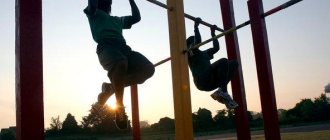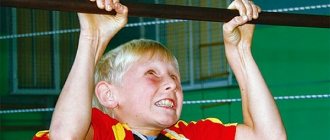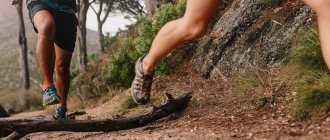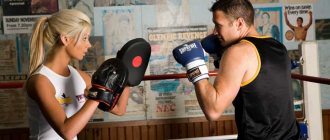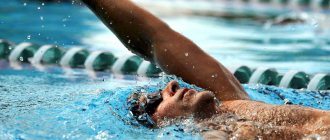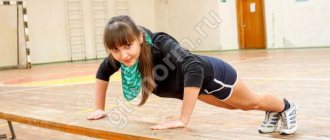Training programsMiscellaneous
The right training program will help you get into good physical shape to mobilize your body's energy reserves and increase your resistance to stress. This article is about how to improve your health through exercise. We'll cover workout routines, the "five pillars" of fitness, and more! Go.
Author:
Mike Mahler
Some iron enthusiasts strive to develop maximum strength and muscle mass; others are interested in muscle definition. But most people don’t care about all this. When asked to advise on a training program, I always ask the person about their goals. In 90% of cases it all comes down to improving physical fitness.
Many coaches, including myself, are puzzled by this answer. It's too vague. We need specifics. After all, how else can you develop an individual training program - for example, to lose weight by 15 kg or to increase your deadlift result by 25 kg?
The fact is that most people look at training a little more simply. It's not uncommon for fitness instructors to assume that regular gym-goers should take their workouts as seriously as possible. This is mistake.
We need to start not from how people should train, but from how they train and what goals they set for themselves. And most people have one goal - to improve their well-being, get in shape and improve their health. A comprehensive program of general physical training contributes to achieving this goal.
What is “general physical fitness”?
This question can be answered in different ways. For some people, this is the ability to run a cross-country race of at least 3 km. For others, bench press 100kg with perfect form.
Any of these answers may be correct, but let's look at fitness from the point of view of the average person: good physical fitness is a level of development of strength that allows you to perform routine activities. That is, you should be able to carry your suitcases at the airport or throw your hand luggage into the overhead bin on the train.
Or you must be strong enough to carry bags from the supermarket to your car in your hands. A trained person will not puff like a steam locomotive after climbing several floors of stairs.
For people seriously involved in strength sports, such indicators are not something outstanding. But this article is not aimed at serious “jocks”, but at ordinary people who want to strengthen their body.
An effective training program will help you get into good physical shape to mobilize your body's energy reserves and increase your resistance to stress. Moreover, properly selected exercises promote the production of serotonin (“the hormone of happiness”) - as a result, your well-being will significantly improve.
So, we have a general idea of what this article will be about. Now let's look at the five key elements of general fitness:
Physical life hacks
Ladder
The ladder is a great training tool. If you live in a multi-story building, great. Don't use the elevator, use the stairs. Even if your apartment is on the ground floor, walk up and down the stairs a couple of times throughout your home. Stair climbing machines have revolutionized the fitness industry in terms of cardio equipment. Today, every self-respecting fitness club has such a portable escalator in its arsenal. This simulator has gained enormous popularity among professional bodybuilders, who have recently increasingly preferred it for cardio sessions, especially during pre-competition preparation. This confirms its maximum effectiveness.
Charger
If you train yourself to spend about ten minutes in the morning doing exercises, then after two weeks you will have acquired a useful habit that will lay a powerful foundation for your further transformation. Light, compound movements immediately after waking up provide a response comparable to a workout at just below average intensity. Minimum costs - maximum efficiency. The main thing here is time logistics. In the morning, when the blood contains a minimum amount of sugar and the concentration of cortisol is above average, any slightest load causes a powerful stimulus for the secretion of anabolic hormones throughout the next day. After charging, you can walk up the stairs a couple of times and multiply the efficiency factor a hundredfold.
Stretching
We will talk in detail about the benefits and types of stretching in a separate article. Now it’s worth noting that regular stretching exercises are an excellent life hack for toning the body. You can conduct a stretching session right in bed! And both in the morning and in the evening. If you make it a rule to devote 7-10 minutes to stretching twice a day, this will be a significant contribution to your total daily energy expenditure. In the morning, stretching helps you wake up and intensify your metabolism, and in the evening it promotes good sleep. The more stretched your muscles are, the better their blood flow and metabolic processes are, and the better you sleep, the more productive each subsequent day will be.
Let's sum up the interim results and get started with food life hacks:
The best investments in getting into good shape are:
- mode;
- morning exercises;
- stretching on a regular basis.
The ladder is a wonderful tool available to everyone everywhere. Use the stairs in the morning after exercise and before an evening stretching session, as well as every time you come or leave home. Don't use the elevator - going down the stairs is more energy-consuming. Moreover, when you go down stairs, you use other muscle groups, which varies the load and generally adds additional stress.
You can also make it more difficult to climb stairs by stepping over one or two steps and do this in a jumping form. Over time, you will do this, because simply getting up will become boring and easy for you.
Force
First of all, let's consider such an element as strength. From the point of view of the modern way of life, the development of strength interests us for two reasons. Firstly, to be able to lift objects from the ground: heavy boxes, water bottles, grocery bags, etc.
Secondly, to lift objects above your head: throw a bag on the top shelf of a train, put a heavy pan in the top compartment of a sideboard, etc. If a person cannot do such simple things, then the quality of his life leaves much to be desired.
The two main exercises that develop strength in these areas are the deadlift and the standing dumbbell press. Progress in these exercises indicates the development of muscle strength throughout the body.
Once you master the deadlift technique, you will learn how to properly lift objects from the ground. You will learn how wide your feet should be to take the load off your lower back. In addition, you can strengthen your back muscles.
In many people, the back muscles are poorly developed, which causes frequent pain. A person begins to avoid back exercises - and this is a big mistake. You need to strengthen your muscles and develop strength, and not indulge your weakness.
Barbell deadlift
Deadlifts are the key to a strong lower back and a strong back in general. The exercise teaches the body to work as a single unit and recruit the maximum number of muscle fibers to resist the load. In addition, deadlifts develop the muscles adjacent to the hip joint well. No trendy exercise can match the effectiveness of the deadlift in creating a strong back.
Deadlifts can be performed with any weight: dumbbells, kettlebells, and even sandbags. However, from the point of view of comprehensive strength development, the most effective is the regular deadlift with a barbell.
Beginners should start with an empty 20kg (or lighter) bar. Experienced athletes can load a weight of more than 200 kg on a barbell, and with a gradual increase. This is the best equipment for developing strength.
Next we move on to the standing dumbbell press. If the barbell is such an effective apparatus, then why is it recommended to perform the standing press with dumbbells? The fact is that for a standing barbell press you need either a power frame or racks so that in the initial position the bar is at chest level.
Standing Dumbbell Press
Quality squat racks cost a lot of money. This is an excellent sports equipment for professional strength athletes, but they are rarely used in regular fitness.
There is another way to “deliver” the barbell to its starting position - an exercise called a barbell clean. Of course, on light weights you can use a regular barbell curl with a reverse grip. However, sooner or later the weight of the burden will increase; throwing the barbell onto your chest this way will become difficult (and traumatic).
For those who do not know what a “barbell clean” is, I’ll explain: this is an exercise in which you need to lift the barbell from the platform to the level of the racks (chest) in one quick movement. A very good exercise, but it requires good coordination and many years of practice.
Barbell Chest Raise
Those who disagree with this statement usually use poor technique or, even worse, teach poor technique to others. Yes, experienced athletes or professional bodybuilders are able to learn the technique of any exercise in a short period of time. The average fitness enthusiast can't do that. In addition, getting injured is not part of a general physical training program.
Again, to keep things simple, we'll use dumbbells. Moreover, beginners can start with one-arm dumbbell press. In this case, both hands are used to lift the projectile to shoulder level. This way you can lift even a very heavy dumbbell.
One-arm dumbbell press
Let's look further. If you can bench press a 35-pound dumbbell, then you certainly have the strength to lift it onto your chest with both hands.
The one-arm dumbbell press allows you to get rid of imbalances in muscle development - here the difference in strength between the right and left hands immediately becomes obvious. To maintain balance in a dumbbell press with one arm, the muscles of the torso are activated (and this is an additional plus).
Now supporters of minimalism will decide that to develop strength it is enough to have only two mandatory exercises in your arsenal, but... this is not so. This approach doesn't work in the long run. The standing press and deadlift are excellent exercises for developing strength. But you can’t limit yourself to them only.
Take, for example, baseball players - after all, they do not only play baseball to stay in shape. In fitness, everything is exactly the same: you should perform different exercises for proportional muscle development and prevent injuries (which are inevitable with an unbalanced training program). Fortunately, the list of recommended exercises is not too long.
You should focus on five areas:
- Press (examples: bench press, military press, push-ups)
- Rows (examples: pull-ups, bent-over rows, lat pull-downs)
- Quadriceps (examples: barbell squats, dumbbell squats, front squats)
- Hamstrings (examples: Romanian deadlift, supine leg curl)
- Abs (examples: hanging leg raises on the bar, torso lifts, side bends with dumbbells)
I usually call these areas the "five pillars" of strength training. To keep your training program balanced, take one exercise from each group and perform them in two to three sets three times a week. For example, you can conduct comprehensive training for all parts of the body on Mondays, Wednesdays and Fridays.
Looking at these “five pillars”, men are probably looking for barbell curls, and women are looking for exercises for the buttocks. All I can say is that while I get paid to instruct strength training, you continue to wonder why your biceps are barely 30cm in circumference after years of bombing your arms several times a week.
Doing a lot of isolation exercises is the wrong way to go. Only basic exercises can provide serious results. Men, your arms already get a tremendous amount of work from bench presses, pull-ups, and rows; they grow precisely from such exercises. Women, your quads, hamstrings, and glutes are maximally recruited by squats and deadlifts. Why do you need isolation exercises?
In strength training, performing basic exercises is the most effective technique. This is especially true for ordinary fitness enthusiasts who do not have the slightest desire to spend their entire lives in the gym.
Below is an example of a strength training program as part of general conditioning:
Monday
- Perform set A-1, rest for one minute, then perform set A-2. Rest for one minute, then begin Set A-1 again. Perform the required number of approaches.
- A-1:
One-arm dumbbell press 2x6 (two sets of six reps) - A-2:
Pull-ups or lat pulldowns 2x6 - Perform set B-1, rest for one minute, then perform set B-2. Rest for one minute, then begin Set B-1 again. Perform the required number of approaches.
- B-1:
Deadlift 2x5 (bend your knees as much as possible to engage your quads and glutes. Your hamstrings will also get a decent workout) - B-2:
Slow and controlled 2x10 sit-ups (four seconds positive, two seconds negative)
Wednesday
- Perform set A-1, rest for one minute, then perform set A-2. Rest for one minute, then begin Set A-1 again. Perform the required number of approaches.
- A-1:
Standing Dumbbell Press 2x6 - A-2:
One-arm dumbbell row 2x6 (each arm) - Perform set B-1, rest for one minute, then perform set B-2. Rest for one minute, then begin Set B-1 again. Perform the required number of approaches.
- B-1:
Dumbbell Squats 2x6 - B-2:
Lunges with 2x6 dumbbells (each leg)
Friday
- Perform set A-1, rest for one minute, then perform set A-2. Rest for one minute, then begin Set A-1 again. Perform the required number of approaches.
- A-1:
One-Arm Floor Press or 2x6 Flat Bench - A-2:
Pull-ups or lat pulldowns 2x6 - Perform set B-1, rest for one minute, then perform set B-2. Rest for one minute, then begin Set B-1 again. Perform the required number of approaches.
- B-1:
Deadlift 2x5 - B-2:
Hanging Leg Raise on 2x10 Bar
The program presented above is one option. You can limit yourself to, for example, two days of strength training (Monday and Thursday) or perform each exercise in three approaches. Or you can focus on your upper body on Monday-Thursday and your lower body on Tuesday-Friday.
In any case, you should build on the specified training program if your goal is to improve your overall fitness. You need to do the program for four weeks, after which you should change the number of repetitions or choose other exercises.
The relevance of general physical fitness training for runners: why do them?
In addition to increasing overall endurance, as well as increasing stamina and strength of the body, general physical fitness training helps in developing and improving coordination of movement while running, and also significantly improves the performance of joints and muscles.
Athletes who periodically perform a set of general physical training exercises are less susceptible to various types of injuries, including sprains. Accordingly, general physical fitness has a positive effect on safety while running, preventing and reducing the likelihood of injury. In addition, the body gets used to some stress, which has a beneficial effect on human health in general.
Running, whether long or short distance, professional or beginner, uses various muscle groups, such as the legs, abdominals, back and shoulder girdle, which support the core and spine during intense running sports activities.
Thus, general physical training for runners helps to evenly develop and develop the entire muscular corset of the runner, consistently paying attention to each muscle group, making them more elastic and flexible, and the joints more mobile.
It is important to take into account the fact that running exercises without proper physical training, carried out in parallel with running, will be much less effective and more traumatic, especially at the initial stage or after long breaks in sports running practice.
Cardio
Now let's look at the cardio element of a general fitness program: aerobic exercise is essential for strengthening the heart, increasing lung capacity and improving circulation, and building endurance—you don't want to be the guy who has incredible strength but can't stand up. fifth floor without elevator.
There is a huge selection of cardio exercises. Preference should be given to the one you like most. For many people, a 30-minute spin class seems like too much of a boring workout.
This is why there is a skeptical attitude towards cardio training, since this type of physical activity is associated with something tedious and monotonous. But you can organize everything differently. If you like tennis, make it your cardio exercise (three sessions a week is plenty). Swimming or walking are also excellent options for cardio exercise (similarly, three sessions per week).
Unfortunately, life is designed in such a way that we don’t always get to do what we like. However, the choice of aerobic exercises is huge. Let's take race walking, for example. Legendary athlete Steve Reeves, a big fan of race walking, made his career at a time when all bodybuilders could boast of good physical shape.
Turn on your favorite music and go for a 30-minute walk. Control your distance – in your next session, your goal will be to walk a greater distance in the same amount of time. If you're uncomfortable with the classic (a little funny) style of race walking with long strides and sweeping arm movements, you can use a weight vest.
The 20kg weighted vest will turn an ordinary walk into an intense cardio workout. Whatever option you choose, you need to increase the load gradually. It is also advisable to invest in a pair of quality walking shoes.
If you prefer to do your cardio exercises indoors on machines, consider interval training. This type of physical activity - also known as "high-intensity cardio" - not only strengthens the heart, but also provides effective fat burning while saving time (the class is twice as fast as a regular cardio workout). Try this technique; within twenty minutes you will become her supporter.
The idea is this: first, do a five-minute warm-up at a moderate pace, after which the pace sharply accelerates for 30 seconds, and then slows down for 90 seconds. The “acceleration-rest” intervals must be repeated ten times. Finish your workout with a five-minute cool-down to normalize your heart rate.
As the body adapts to the load, begin to shorten the rest time in each interval - for example, after 30 seconds of acceleration followed by 50 seconds of a moderate pace. You should aim for equal periods of acceleration and rest over time - 30 seconds each.
Cycling is another great way to mix up your cardio workout.
There are other options for interval training, including jump rope or a circuit of bodyweight exercises (push-ups, squats, squat jumps, jumping jacks). You don't have to do the same thing over and over again! Vary the exercises to keep your workouts fun.
For example, on Tuesdays you can go to the pool, on Thursdays you can do race walking, and on Saturdays you can do an intensive training cycle at home. The most important thing is to do three cardio workouts a week. Then you are guaranteed to improve the functioning of the cardiovascular system and develop the body's endurance.
There are also a large number of interesting training programs aimed at developing endurance and general strengthening of the body, such as the 100 push-ups, 200 presses and 200 squats program.
Methodology of conducting classes.
Health is an invaluable asset not only for every person, but also for the entire society. When meeting or parting with close and dear people, we wish them good and good health, since this is the main condition and guarantee of a full and happy life. Health helps us fulfill our plans, successfully solve major life problems, overcome
difficulties, and if necessary, then significant overloads. Good health, wisely maintained and strengthened by the person himself, ensures a long and active life.
There are three types of rest: daily, weekly and annual. Daily rest includes short breaks during the working day to perform industrial exercises. It is advisable to spend part of the time allotted for a lunch break in the fresh air. When conducting industrial gymnastics, it is advisable to pay more attention to movements that help relax tired muscles.
Industrial gymnastics is a set of simple physical exercises included daily in the working day in order to improve the functional state of the body, maintaining a high level of working capacity and maintaining the health of workers. In addition, gymnastics helps prevent diseases caused by specific working conditions in certain professions.
There are many professions where the load on the neuropsychic sphere is very high and increased attention, vision, and hearing are required, that is, fatigue of the nervous system occurs. As a rule, such professions are associated with limited physical activity.
With a long stay in a sitting position and low motor activity, the intensity of metabolism and blood circulation decreases, blood stagnation appears in the pelvic organs and legs, muscles weaken, and posture worsens. People whose profession involves low mobility are more likely to suffer from headaches, diseases of the cardiovascular system, metabolic disorders, etc.
Industrial gymnastics compensates for the lack of physical activity in a number of professions. In professions associated with heavy physical activity, gymnastics eliminates the adverse effects that stress has on the same muscle groups, involves previously inactive muscle groups, or changes the nature of the activity of working muscles. Exercises for industrial gymnastics complexes, the time and methodology for their implementation are selected taking into account the characteristics of work, the physical development and physical fitness of workers, changes in the functional state of the body during the working day, and sanitary and hygienic working conditions.
For professions where quick and accurate reactions are required, high levels of attention and physical training breaks can be carried out 1-3 times a day using the usual group method. For mental workers, as well as those engaged in light and moderate physical labor, including those whose work requires being on their feet most of the day, individual physical education breaks or physical education minutes (2-3 minutes) are recommended during short breaks in work. the purpose of reducing fatigue resulting from prolonged sitting, standing, forced uncomfortable working posture, strong attention and vision.
It is advisable to periodically diversify physical exercises in complexes, replacing them (about once every 10-14 days) with new ones that are similar in their effect on the body. The time for physical education breaks and physical education minutes is set depending on the working day schedule. In the first part of the working day, a physical training break should be done after about three hours of work; it can also be done in the second half of the day. Gymnastics classes are carried out, if conditions permit, directly at the workplace, preferably with music. The room must be ventilated before performing gymnastics. Systematic exercise in the fresh air will increase the body's resistance to hypothermia. Sets of exercises broadcast on the radio and offered by television are intended for people whose work involves low mobility (mental as well as light physical work. The broadcast time, of course, cannot suit everyone, since the beginning of the working day is different, so it is recommended to record sets of exercises on film and play back at the most convenient time. It is not recommended to use the lunch break for classes. It is prohibited to conduct classes indoors at air temperatures above 25C and humidity above 70%.
Joint mobility, flexibility and balance
Next we have joint mobility, flexibility and balance. In the elite division, many athletes lift weights of over 300 kg on the bench press, but cannot reach the tips of their toes. From the point of view of general physical fitness, this situation is not normal.
Of course, no one requires you to stretch like a circus acrobat, but it is necessary to have a certain level of balance, mobility and flexibility. Reaching your toes is a simple but effective way to measure flexibility.
Bottom line: If you can't reach your toes with your knees slightly bent, your muscles and joints are too stiff. If you can't stand on one leg for thirty seconds, you need to develop your balance.
If you can't reach your fingertips with your knees slightly bent, your muscles and joints are too stiff
Finally, the ability to hold the bottom of a deep squat (without a barbell) for thirty seconds indicates good joint mobility. These minimum standards of mobility, flexibility and balance are indicators of the general level of physical development of any person.
Some people need to work hard to learn how to comply with these standards. And others have such innate flexibility that one can only envy. In any case, I advise you to include stretching exercises in your general physical training program, and also perform them in the morning after getting out of bed.
Hindu squats are considered one of the best exercises for developing joint mobility. Exercise improves leg flexibility and blood circulation.
It is recommended to start the exercise with 25 repetitions. To get the most out of Hindu squats, try to breathe deeply, inhaling deeply as you rise up from the squat and exhaling as you lower down. Deep breathing promotes the production of epinephrine, the “happy hormone,” which strengthens the lungs and relieves stress.
There is another good exercise for improving blood circulation and developing flexibility - kettlebell swings. Hold a light weight with both hands; take it back between your legs and perform a sharp swing forward, lifting the projectile above your head. Do 25 reps to warm up and stretch your muscles. If you don't have a weight, you can use a dumbbell.
Do these exercises regularly to maintain good flexibility. And it happens that a person gets out of bed, has breakfast (sitting), goes to work (sitting), and then spends the whole day in front of the computer (also sitting). Sounds familiar?
I often work at home, and my “path to the office” runs from the bedroom to the living room, where my laptop is. As a result, I came to the conclusion that in the morning you need to drink a couple of glasses of water, walk the dog, and then do a few stretching exercises - then you will feel energetic and eager to work all day. I don’t accept it when a person sleeps for eight hours in a row, wakes up, goes to work and again sits in one place all day; you need to constantly move and do something.
Mobility and aerobic exercises can be done in the morning. With strength training it's a little different. As a rule, in the morning the muscles and joints are a little stiff - it is better to postpone strength training until later. Mobility exercises can also be done immediately before strength training.
What about stretching? I would recommend stretching after strength training and aerobic training. The muscles will be warmed up and become more flexible. The effectiveness of stretching will increase and the risk of injury will decrease. At the end of the article are examples of stretching exercises that can be included in a general physical training program.
To develop balance, you need to stand on one leg (both right and left): at first for at least thirty seconds. Over time, the duration of the exercise should be increased, trying to reach one minute or more. After this, you can proceed to perform the exercise with your eyes closed: starting with thirty seconds and trying to reach ninety.
Undoubtedly, you cannot build a general physical training program on strength training alone (without cardio exercises and exercises to develop flexibility/mobility). We must focus not only on muscle strength, but also on normal heart/joint function. However, the physical aspect of health is only part of the equation. Let's move on to the next "pillar" of fitness, i.e. to nutrition.
Three general physical fitness complexes
First set of exercises (for beginners)
- standing on the floor, start doing squats with your arms extended forward. 3 squats 7 times;
- perform downward bends with straight legs, trying to touch your toes with your hands. The legs should not be bent at the knees; it is important to bend, trying to feel the stretching of the muscles as much as possible. 3 tilts 7 times;
- extend your arms forward and make swinging movements like “scissors” 10-15 times;
- do a regular plank, holding it for a minute;
- lying on the floor on your back with your knees bent, do pull-ups with your body without lifting your lower back, thus pumping your abs 3 times 7 times.
Second set of general physical training (medium difficulty)
- start your workout by stretching and warming up your muscles by bending forward, to the sides, back and down. Scheme: 3 tilts 10 times;
- do a plank - regular or side, for 1-2 minutes;
- pull yourself up on the turnstile or from the floor in 5 steps, repeat 10 times;
- lying lateral leg raises. Lie on your side on a fitness mat, rest your hand on the floor and slowly begin lifting with your straight leg. Repeat 10 times with each leg. To make it more difficult, you can keep your leg straight in the air while lifting;
- perform the “invisible chair” exercise, hanging in a sitting position in the air and leaning your back on a vertical surface. The duration of this task is about 2-3 minutes;
- running in place to warm up the muscles for 5-7 minutes.
Third complex of general physical training (for professionals)
- perform bends, swings with legs and arms for 5-10 minutes;
- rotational movements forward and backward with the shoulders – 5 minutes;
- regular plank, side plank or on bent arms – 2 minutes;
- abdominal swing lying on your back – 20-30 times;
- wide and narrow push-ups from the floor – 15-20 times;
- pull-ups on the turnstile – 15-20 times;
- lifting the leg backwards. Get on all fours and, moving one leg back and up, stay in this position for 30-60 seconds. Repeat with the other leg. Perform this technique 15 times;
- turns the body while lying on a sports mat. Lie on your back, place your hands behind your head, bend your knees and slowly bend your legs alternately in one direction or the other;
- walk or run in place for 10 minutes.
All sets of exercises cover the necessary muscle groups, which are especially important for runners to train. The difference is only in the degree of intensity of the load over time and in the complexity of performing some techniques. It is worth paying attention that all exercises should be performed as smoothly as possible, avoiding sudden movements. Performing these techniques slowly will only benefit you, while moving too quickly and vigorously can cause pain and damage your muscles or joints.
With regular and correct performance of general physical training exercises, the quality of running at any stage will significantly improve. The speed and endurance of the body will increase, the muscles will become more flexible and elastic, and the spine and joints will become more mobile. Long distances will be less exhausting, and if general physical training was performed immediately before running, the athlete will receive a guaranteed boost of energy for the whole day.
Important! It is best to create sets of general physical fitness exercises with a specialist, especially if you have any diseases, including those of a chronic nature.
Nutrition
Training will never bring results if a person eats poorly. Of course, even the most avid sweet tooth can maintain normal body weight if he spends half a day in the gym. But “slim” and “healthy” cannot be equated.
Occasional diet violations are acceptable as long as you have a proper strength training program. In his wonderful book “The Cheater's Diet,” Joel Marion writes that a one-time diet violation for a week helps to increase the level of leptin in the body, a hormone that regulates energy metabolism.
Great news - breaking away from the once-a-week diet is not only possible, but necessary! Remember, we are talking about one day, not all seven. For the remaining six days, we should follow the recommendations of Ori Hofmekler, author of The Anti-Estrogen Diet, to eat lower in the food chain.
This means that you should lean on fruits and vegetables with a low glycemic index: berries, tomatoes, oranges, apples, spinach, peppers, broccoli, cauliflower, etc. This means that we should get protein from beef and dairy products, legumes, nuts, and seeds.
Lastly, we should choose healthy sources of fats: buffalo butter, olive oil, avocado, almond butter, nuts and seeds. If you consume such foods, the effectiveness of your training program will significantly increase. Once a week you can eat whatever you want, without any twinges of conscience, since the importance of our relationship to food is difficult to exaggerate.
What about the number of meals? Five times a day, three times, once? There are many answers to this question. Some fitness instructors and nutritionists recommend eating small meals five times a day. I cannot agree with this point of view for two reasons.
Firstly, too much time will be spent on cooking. Most of us don't have time to go to the kitchen that often (the thought of eating five meals a day can be irritating). ]sports nutrition[/anchor] know this well, which is why there is a huge selection of protein mixtures and bars on sale. But consuming products of dubious quality that have undergone complex technological processing carries a certain health risk.
Secondly, a five-meal diet is ineffective, since it does not allow a person to get enough: every time you have to get up from the table with a slight feeling of hunger. You will constantly think about food, looking forward to the next meal (which again will not make you feel full). Let's be honest - we all love to eat well (we're not talking about filling our bellies to capacity; we're talking about simply satisfying our hunger).
In his books The Anti-Estrogen Diet and The Warrior Diet, Ori Hofmekler writes that the secret to proper nutrition is to have one large meal a day. It’s better if it’s dinner (when all the problems and worries are left behind). After all, how nice it is to come home after a hard day at work and have a nice dinner.
But this does not mean that we should sit on a starvation diet all day - it is unlikely that anyone will be able to withstand such a diet for a long time. On the contrary, you need to organize regular snacks throughout the day: smoothies, salads with nuts, fruits, vegetables - any products from the bottom of the food chain that are easily absorbed by the body. The digestion process takes a lot of energy, which can cause fatigue and apathy.
A heavy breakfast can cause decreased performance. A hearty lunch is a good option... if you can take a nap for an hour or two afterwards. Only through experimentation can you determine the optimal diet for yourself. Some people are used to eating more often, others less often.
Try to plan your day so that your most nutritious meal is in the evening, ideally after a workout. You should have dinner a few hours before bedtime. Not for the purpose of preventing excess weight (this is a myth), but to avoid problems with insomnia.
Recommendations for performing general physical training: the best time for training
It is preferable to train every time before starting a run. In this case, in addition to all the other benefits of general physical fitness, the body will be sufficiently warmed up and completely ready to run, which will significantly reduce the likelihood of subsequent muscle soreness after long runs.
General physical training is recommended to be performed at any time of the year. During the warm season, it is advisable to do these exercises in the fresh air, and running itself will be much more useful and enjoyable in the open space.
It is important to remember that the best effect from these exercises can only be achieved through regular training. The optimal amount of general physical training for an average runner is about 4 times a week, if running classes are held 3 times a week. Accordingly, for each day of running there should be one general physical training event plus one free day on which general physical fitness training would be carried out without subsequent running practice. This will help keep the body and muscle corset in good shape, reducing the likelihood of muscle strain.
As a harmonious, balanced scheme for the gradual development and strengthening of the entire body as a whole, this workout will be useful for both professional runners and beginners. Therefore, it is strongly recommended to include general physical fitness classes in your training plan for all people interested in and involved in any sport, without exception, and this is especially true for running. The age and gender of the athletes do not matter. The only thing you should pay close attention to when drawing up a general physical training plan is the individual characteristics of the body and the athlete’s well-being.
Important! Before starting general physical training, it is recommended to consult a specialist, especially if you have any diseases.
Recovery
So, we come to the last “pillar” of the general physical training program - recovery. (Just in time, because you will definitely want to take a break after reading such a long article.) We live in a society of busy people. The busier we are, the higher our social status.
We despise laziness, although the percentage of obese people in our country is growing. Work gives us a fulfilling life. But the ability to enjoy all its joys directly depends on the body’s recovery program. Just as a car requires repairs and maintenance, our body needs periodic rest.
The most important component of a recovery program is adequate sleep. The problem of lack of sleep is widespread in our country. It’s not for nothing that there are coffee vending machines on every corner. In the hope of deceiving nature, we steal our sleep by using artificial stimulants - over time, this leads to problems with the adrenal glands.
The importance of deep sleep is due to several reasons: firstly, we see dreams, which are necessary for normal mental health and peace of mind; secondly, the body produces large quantities of anti-aging hormones (testosterone, dehydroepiandrosterone, pregnenolone and growth hormone); thirdly, during sleep, processes of restoration and replenishment occur in the body.
Lack of sleep literally accelerates the aging of the body (the less you sleep, the faster you age). Chronic lack of sleep negatively affects not only our health, but also the people who surround us, because we vent our aggression and discontent on them.
One of the reasons for poor sleep quality is the inability to deal with stress. The source of stress is not the events occurring in a person’s life, but his attitude towards these events. Our perception is to blame for everything.
You need to constantly work on yourself to learn how to overcome stress. Meditation is best for this. There are various meditation techniques. You can, for example, practice qigong or tai chi. Or just walk around the city, watching your breathing.
It is not necessary to sit in the lotus position and recite mantras; For example, after training or before bed, I go out to get some fresh air and also listen to calm music.
While the music is playing, I take deep breaths through my nose. During such meditations, I almost always fall asleep, and when I wake up, I feel a surge of strength. Meditation is not a fad. Wise people have been practicing this technique for many millennia. I recommend everyone to use meditation in their training program.
There is another effective component of the recovery program - massage. A good weekly massage does wonders for our muscles and also improves our overall well-being. If it is expensive for you to visit the massage room every week, you can do it once every two weeks. As a last resort, you can go to a massage therapist once a month. If you can’t afford this option, give up cable TV and mobile communications... or find a job with a higher salary.
The quality of the massage depends on the specialist who does it; You may have to visit several massage parlors until you find your massage therapist. A qualified specialist conducts a massage session taking into account the characteristics and wishes of a particular client.
The last element of the recovery program - which doesn't cost a dime - is deep breathing. As soon as you feel stress increasing, start breathing deeply. On the count of five, inhale through your nose, hold your breath for ten seconds, then exhale on the count of five. Try to breathe slowly and intensely, holding your breath as long as possible.
As the famous bodybuilder Steve Reeves said, deep breathing increases the level of the happiness hormone - epinephrine. A person gets a high without external stimulants. Animals have this at the level of instinct; they always breathe deeply.
As I write this, my dog Mona is laying down on the floor doing a “breathing therapy session”; breathing is performed more by moving the abdomen rather than the chest. Mona always breathes deeply. In stressful situations, a person holds his breath. It is not right. The level of stress in the body only increases. You should always breathe deeply and freely.
Why does a long-distance runner need strength training?
- to reduce the risk of injury
One of the causes of common running injuries is muscle imbalance. Some muscles are better developed in us, others - worse. Not all of them can be strengthened through running alone. We begin to add running load, and the body has to adapt - to compensate for what is weaker at the expense of what is stronger. As a result, incorrect motor patterns are developed, technique is disrupted, and distortions occur—excessive load on certain parts. When their safety margin is not enough, injuries occur.
Through strength training, you can achieve more balanced development, specifically strengthening weak areas, and reduce the risk of injury.
What helps me run without injuries (over 8 years and 20,000 km)
- to run more economically and efficiently, and therefore faster
Standard situation: we run, after some time we get tired and the first thing that “flies” is our posture. We shrink, we hunch over, our technique is disrupted - it becomes harder to run, more energy is consumed. It is also more difficult for the lungs to work with the diaphragm in such “squeezed” conditions. Just suffering.
The correct position of the pelvis and chest relative to each other is ensured by the work of the muscles of the back, abs, buttocks and thigh biceps. In this case, gas exchange is more efficient, fatigue accumulates less, and endurance is higher. In addition, the “arm-leg” ligament works more clearly. Running efficiency increases: less energy is spent on the same work.
The quadriceps is one of the main running muscles, which moves the knee and hip joints forward, is responsible for flexion and extension of the knee, and takes part of the shock load when landing. Developed quadriceps = effective stabilization of the knee joint and increased speed.
A common problem among runners is weak gluteal and hamstring muscles. Strengthening them through exercises helps make the push off more efficient and stronger, and reduces the stress on the knees, hips and ankles.
- to maintain optimal weight and body fat percentage
Losing weight to run faster is a constant in the plans of many runners.
